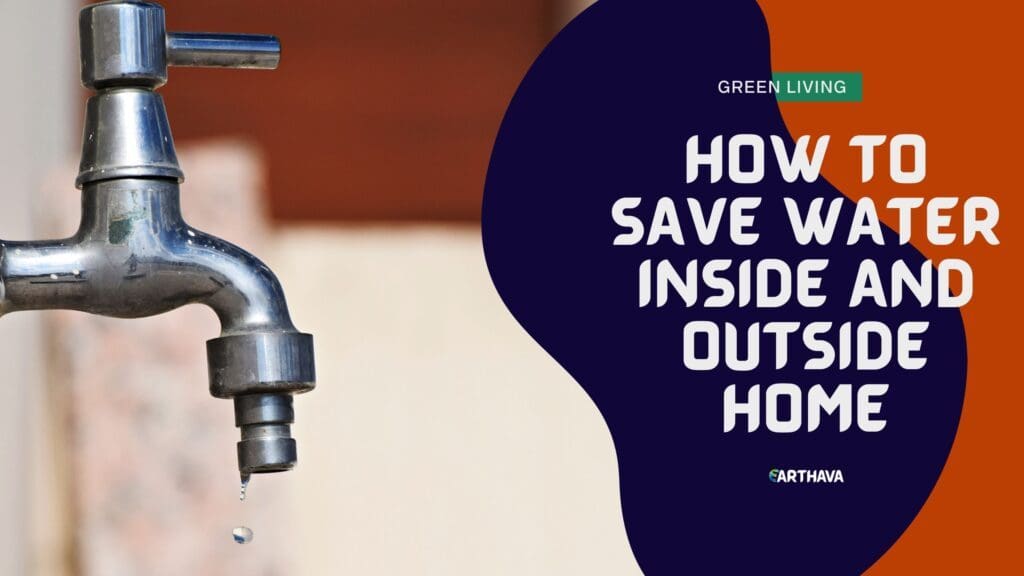Humans, plants, and animals have one major thing in common: we all need water to survive.
Scientists and experts are constantly on the lookout for new and improved ways to conserve water, one of the earth’s most precious natural resources.

In the meantime, we can do our part to start right now, in our own homes. If you’ve been wanting to join the efforts of water conservation, but you’re not sure just where to begin, keep reading. I’ve got some water-saving hacks for both inside and outside that you can start doing right now.
How to Save Water Inside
Adulting was a rude awakening for me, especially when I saw my first water bill. It was at that moment that I started to look all around my home and consider just how much water I was using, and how much of that was unnecessary. It turns out that the average person in the US uses 80-100 gallons of water a day.
As I did more research, I also learned how important our efforts are in saving water, so I’ve made a commitment to make some changes in how I use water in the home. These are all fairly simple tips that will help you do the same.
In the Kitchen
Between the dishwashing, the drinking water, and the cooking, we use a lot of water in this area of the house. Try a few of these tricks to cut back on wasting water:
- Only run the dishwasher when it’s full.
- Try to avoid using running water to rinse dishes.
- Use cooled water from boiling pasta or veggies to water your plants.
- Replace old, leaky faucets.
- Turn off the ice maker.
- Soak any soiled dishes in the sink together, to get rid of any debris before hitting the dishwasher.
- Fill a water bottle and keep it in the fridge, instead of running water until it’s cold enough.
- Try plant-based milk, it requires less water to produce.
- Start composting.
- Stay on top of cleaning up spills and try not to do an overall mopping too often.
In the Bathroom
This room is right up there with the kitchen. Flushing toilets, bathing, brushing teeth and showering all use water. If you implement just a few of these, you’ll already be making a difference:
- Turn off the water when you’re brushing your teeth.
- Take showers and avoid baths, showers use less than 25 gallons of water while baths use at least 70.
- Install a high-efficiency toilet, or just flush when necessary.
- Switch out your showerhead for a new, low-flow showerhead.
- Turn down the shower pressure or off completely, when shaving.
- Try an instant water heater that warms water as you need it.
- If you have to run the water to let it heat up, catch it in a bucket and use it to water plants.
- Use a sink stopper when you’re shaving at the sink.
- If you can, take a quick shower, or even skip it.
- Add water aerators to your faucets.
In the Laundry Room
Unfortunately, quitting laundry altogether just isn’t an option for most of us, even though I’d be fine with that. However, when I do have to finally do laundry, it does help to know that I’m doing a little bit of good when using these tips to save water:
- Use cold water cycles to wash your clothes.
- Only do a load of laundry if it’s full, no washing just a few things here and there.
- If possible, upgrade your washer to a more energy-efficient model.
- Reuse towels, there’s no need to wash after every use unless towels are soiled.
- Same with clothes, this is also better for the wear and tear.
- Make sure the “extra rinse” option is turned off of your machine.
- This goes for the permanent press cycle, too. It also uses an extra rinse.
- Keep an eye out for leaks and fix them right away.
- Choose the cycle size that’s appropriate for the amount of laundry you’re doing.
- Skip the dryer if you can, this saves energy which in turn saves water. Air drying is also better for the fabric.
How to Save Water Outside
Saving water outdoors is just as important as doing it indoors, even if you live in a climate where you can’t be outside for parts of the year. However, an estimated 9 billion gallons of water are still used for outdoor purposes each year. That number could easily be reduced by adding any of these practical solutions to your outdoor water usage:
- Don’t water the lawn when it’s hot or windy outside.
- Give your lawn a good soaking every few days, instead of watering every day.
- Check your plants to see if they do need watering, to avoid wasting water and overwatering your plants.
- Use mulch around plants.
- Turn off fountains when they don’t need to be on.
- If you have a pool, make sure the water isn’t overflowing.
- Keep your pool covered to avoid the need to refill.
- Wash your car with a bucket and soapy water instead of a constantly running hose.
- Sweep sidewalks and driveways with a broom as opposed to washing off with a hose.
- Use ice cubes to water hanging plants and planters, to avoid water from overflowing.
All of these things are very easy to add to your own lifestyle, and won’t upset your daily routine too much. I’m a creature of habit and don’t do well with change, but I’ve embraced all of these water-saving tricks into my own life, so I’m sure you can too.


